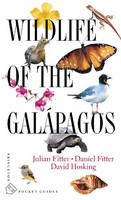
Wildlife of the Galápagos
Princeton University Press (Verlag)
978-0-691-10295-5 (ISBN)
- Titel erscheint in neuer Auflage
- Artikel merken
The Galapagos is a truly special place. Unlike the rest of the world's archipelagoes, it still has 95 percent of its prehuman quota of species. Wildlife of the Galapagos is the most superbly illustrated and comprehensive identification guide ever to the natural splendor of these incomparable islands--islands today threatened by alien species and diseases that have diminished but not destroyed what so enchanted Darwin on his arrival there in 1835. Covering over 200 commonly seen birds, mammals, reptiles, invertebrates, and plants, it reveals the archipelago's striking beauty through more than 400 color photographs, maps, and drawings and well-written, informative text. While the Galapagos Giant Tortoise, the Galapagos Sea Lion, and the Flightless Cormorant are recognized the world over, these thirty-three islands--in the Pacific over 600 miles from mainland Ecuador--are home to many more unique but less famous species. Here, reptiles well outnumber mammals, for they were much better at drifting far from a continent the archipelago was never connected with; the largest native land mammals are rice rats.
The islands' sixty resident bird species include the only penguin to breed entirely in the tropics and to inhabit the Northern Hemisphere. There is a section offering tips on photography in the Equatorial sunlight, and maps of visitors' sites as well as information on the archipelago's history, climate, geology, and conservation. Wildlife of the Galapagos is the perfect companion for anyone who wants to know what so delighted Darwin. * Covers over 200 commonly seen species including birds, mammals, reptiles, invertebrates, plants, and coastal and marine life * Illustrated with over 400 color photographs, maps, and drawings; includes maps of visitors' sites * Written by wildlife experts with extensive knowledge of the area * Includes information on the history, climate, geology, and conservation of the islands * The most complete identification guide to the wildlife of the Galapagos
Julian Fitter, vice-president of the Galapagos Conservation Trust in the UK, first visited the Galapagos in 1964 and went on to spend fourteen years there, establishing the islands' first charter yacht business. His son Daniel Fitter leads nature tours in the Galapagos and on mainland Ecuador. David Hosking, a Fellow of the Royal Photographic Society, is the coauthor of "Wildlife of East Africa". A frequent visitor to the Galapagos for more than three decades, he has published in a wide range of magazines and books.
Foreward 4 The Authors 5 Acknowledgements 6 Conservation Plea 7 Introduction 8 National Park Rules 12 A Travellers' Guide to Safari Photography 14 Key to Species' Status 22 Birds 23 Reptiles 82 Aquatic Mammals 100 Land Mammals 112 Invertebrates 114 Plants 134 Geology and Vulcanology 200 History 206 Ocean Currents and Climate--El Nino 212 Conservation 216 Notes for the Visitor 221 Visitor Sites 222 Bibliography 247 Glossary 249 Index 250
| Erscheint lt. Verlag | 21.7.2002 |
|---|---|
| Reihe/Serie | Princeton Pocket Guides |
| Zusatzinfo | 400 color illus. |
| Verlagsort | New Jersey |
| Sprache | englisch |
| Maße | 114 x 191 mm |
| Gewicht | 369 g |
| Themenwelt | Sachbuch/Ratgeber ► Natur / Technik ► Natur / Ökologie |
| Reisen ► Reiseführer ► Südamerika | |
| ISBN-10 | 0-691-10295-3 / 0691102953 |
| ISBN-13 | 978-0-691-10295-5 / 9780691102955 |
| Zustand | Neuware |
| Haben Sie eine Frage zum Produkt? |
aus dem Bereich



